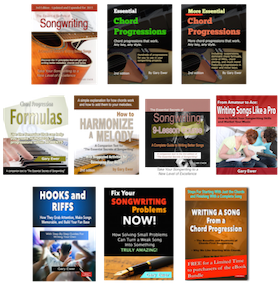What does the word energy mean in music, and what role does it play? There are several possible ways to use that word when discussing music, and songwriting in particular. Energy might involve any, or a combination of, the following:
- Loudness; we think of louder music as being more energetic.
- Tempo; energetic music is often faster.
- Instrumentation; in general, the more instruments that are playing, the more we perceive a sense of heightened musical energy.
- Melodic range; higher melodies tend to be felt as being more energetic, though this is a phenomenon more associated with the human voice, somewhat with guitar, less so with piano or computerized sounds.
- Harmonic rhythm; the more frequently and quicker chords change, the more energy is perceived.
Those are all true most of the time, and the notion of energy in music is even more complex than that. But those are merely symptoms or side effects of energy. What’s really going on when we perceive energy in music?
 “Hooks and Riffs: How They Grab Attention, Make Songs Memorable, and Build Your Fan Base“ shows you how and why hooks are so important to songs in the pop genres. It’s part of the 10-eBook Deluxe Bundle. READ MORE
“Hooks and Riffs: How They Grab Attention, Make Songs Memorable, and Build Your Fan Base“ shows you how and why hooks are so important to songs in the pop genres. It’s part of the 10-eBook Deluxe Bundle. READ MORE
The most relevant way to think of musical energy is in its effect on the listener, and in that regard, this might be a better (even if slightly inaccurate!) description: energy is any change in music that compels a listener to want to keep listening.
When you write a song, you are actually creating what might be thought of as a kind of sound event in which you take a listener on a musical journey. Regardless of genre or topic, it is a journey that explores all the possibilities of tension and release.
By tension and release, we mean that your song is constantly creating a hopefully pleasant form of musical stress, and then allowing that stress to find its resolution. And that happens in every aspect and element that you put together to form your song.
For example, if you begin your song by strumming a C chord on your guitar, tension is low, close to nonexistent. Once you play your next chord (F, let’s say), you move away from C, and most of the time the listener hears (in retrospect) that C was the tonic chord, and you’re moving away from it; tension is increased. Following that F with a G7 creates even more tension, as the listener wants to hear G7 resolve to C. When it does, tension is released in a very desirable way.
This kind of up-and-down pattern of tension and resolution is happening all along the length of any good song, and chord progressions are but one of many elements that songwriters manipulate. Songs without tension are uninteresting to people. A song that builds tension keeps listeners engaged and interested, because on a subconscious level they want to hear how that small bit of tension eventually resolves.
As one song element creates tension, it’s not unusual for other elements to create tension in partnership with it, and so even though there’s a sense of independence, there’s also a collaboration, giving us a map that might potentially look something like this:

The concept of tension and release is a representation of musical energy, and it’s very important for songwriters to think about this. Tension and release act as a kind of musical pump that generates energy.
Besides chords, what are the other ways that songwriters generate musical energy? They create tension and release in the following ways:
- Lyrics: A verse lyric describes people or events in a way that creates the need for an emotional outpouring that typically happens in the chorus. Listeners want to hear the chorus lyric especially if the verse has done a good job of touching on a universally sensitive topic (love, friendship, etc.)
- Volume: As music gets louder (usually in the latter half of a verse), a listener feels compelled to experience how loud it will eventually become.
- Instrumentation: As instruments are added, they contribute to the energy of volume. As instruments are taken away (for Verse 2, for example), listeners feel an urge to keep listening as the missing instruments are eventually added back into the mix.
- Vocal range (melody): It’s not unusual for an audience to be more interested in high notes than low notes. If a singer starts low, there is a subconscious belief that the high notes are coming, and there is a desire to wait for those notes. It means that vocal range, at least in most songs, becomes an important factor in keeping audiences listening.
 Written by Gary Ewer. Follow Gary on Twitter
Written by Gary Ewer. Follow Gary on Twitter
 “The Essential Secrets of Songwriting” eBook bundle packages discuss every aspect of what makes good music, including how to write great chord progressions, melodies, lyrics, and more. Get the 10-eBook Deluxe Bundle Deal: READ MORE..
“The Essential Secrets of Songwriting” eBook bundle packages discuss every aspect of what makes good music, including how to write great chord progressions, melodies, lyrics, and more. Get the 10-eBook Deluxe Bundle Deal: READ MORE..











Pingback: How Tension and Release Makes Audiences Want to Listen - The Hit Songwriting Formula | The Hit Songwriting Formula